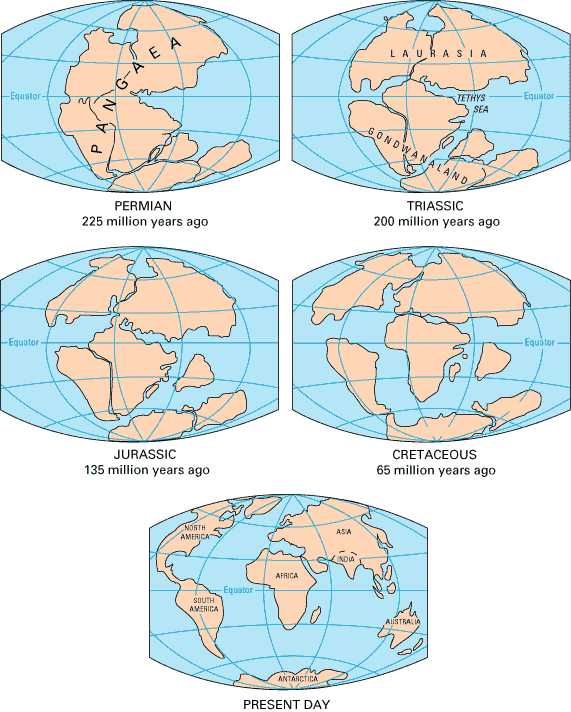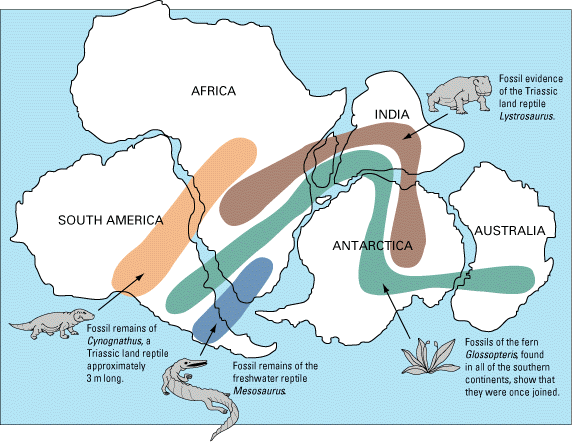ヴェーゲナー『大陸と海洋の起源(上・下)』(都城秋穂・紫藤文子訳訳、岩波文庫、1981年)。
『〔内容〕
1.ドイツの気候学者アルフレッド・ウェゲナーは、1910年壮大な大陸移動説を提唱した。ウェゲナーの考えた超大陸パンゲアを現在の大陸分布と比較して説明する。
2.ウェゲナーの大陸移動説の根拠となった南アメリカとアフリカの海岸線の形の類似、南半球の氷河遺跡の分布の復元を見る。
3.ウェゲナーのパンゲアと現代のパンゲア復元図を比較して示す。新しいパンゲアでは、北のローラシア大陸と南のゴンドワナ大陸の2つのブロックに分かれることをのべる。
4.次に、現代の新しい証拠の数々を紹介する。まず、南アメリカとアフリカの地質構造や古い岩石のつながりをとりあげ、両大陸がかつて接続していたことをのべる。
5.ローラシア大陸では、4億年前おカレドニア造山帯が1つにまとめて復元できることを示す。
6.ゴンドワナ大陸のうち、南極大陸とオーストラリアでの造山帯のつながりを見る。
7.パンゲア全体での造山帯や地層の年代のつながりを見る。
8.古地磁気上での移動の証拠についてのべる。地質時代の磁北極の移動経路は、各大陸で個々に調べると別のルートになるが、大陸がまとまっていたとすれば1つのルートになることを説明する。
9.海底での移動の証拠として、海底山脈の両側に海底の拡大を示す地磁気の縞模様があることをのべる。あわせて海底堆積物の微化石にもその証拠があることをのべる。
10.大陸移動の原動力として有名な仮説であるマントル対流について、シリコンオイルとパラフィンを使ったモデル実験で説明する。
11.マントル対流の仮説などをもとに発展させられたプレート・テクトニクス理論を、アニメーションを用いて説明し、大陸移動のしくみがうまく説明できることをのべる。
12.最後に、将来も大陸移動がつづくならば世界地図はこう変わるだろうという予想図を示してしめくくる。』
 |
Alfred Lothar Wegener (1880-1930), the originator of the theory of continental drift. (Photograph courtesy of the Alfred Wegener Institute for Polar and Marine Research, Bremerhaven, Germany.) |
|
〔W. Jacquelyne Kious and Robert I. TillingによるThis Dynamic Earth: the Story of Plate Tectonicsから〕 |
|
 According to the continental drift theory, the supercontinent Pangaea began to break up about 225-200 million years ago, eventually fragmenting into the continents as we know them today. 〔W. Jacquelyne Kious and Robert I. TillingによるThis Dynamic Earth: the Story of Plate Tectonicsから〕 大陸移動説によれば、超大陸パンゲアは約2億年前に分裂を始めた。 |
 As noted by Snider-Pellegrini and Wegener, the locations of certain fossil plants and animals on present-day, widely separated continents would form definite patterns (shown by the bands of colors), if the continents are rejoined. 〔W. Jacquelyne Kious and Robert I. TillingによるThis Dynamic Earth: the Story of Plate Tectonicsから〕 現在見られる動植物の化石の分布は、当時大陸が合体していたと考えると説明できる。 |